Webb Stores: Data Migration Plan, Risks, and Security Measures
VerifiedAdded on 2020/03/28
|5
|1874
|45
Report
AI Summary
This report presents a data migration plan for Webb Stores, a retailer, transitioning its data management infrastructure from MS SQL Server 2012 R2 to a cloud-based IaaS infrastructure. The plan addresses key advantages such as flexibility, responsiveness, and cost savings. The report emphasizes the importance of security, recommending measures like private cloud implementation, data access procedures, authentication/authorization, and comprehensive logging. It also explores the risks associated with database architecture, performance, interoperability, and security/privacy concerns during the migration process. The report further discusses risks and issues related to cloud data backup, including data size, security, retrieval, expenditure costs, and backup/recovery time. The report concludes by highlighting the need for robust access control, encryption, and data redundancy mechanisms to ensure data security throughout the migration and backup processes. The report references various sources to support its findings and recommendations.
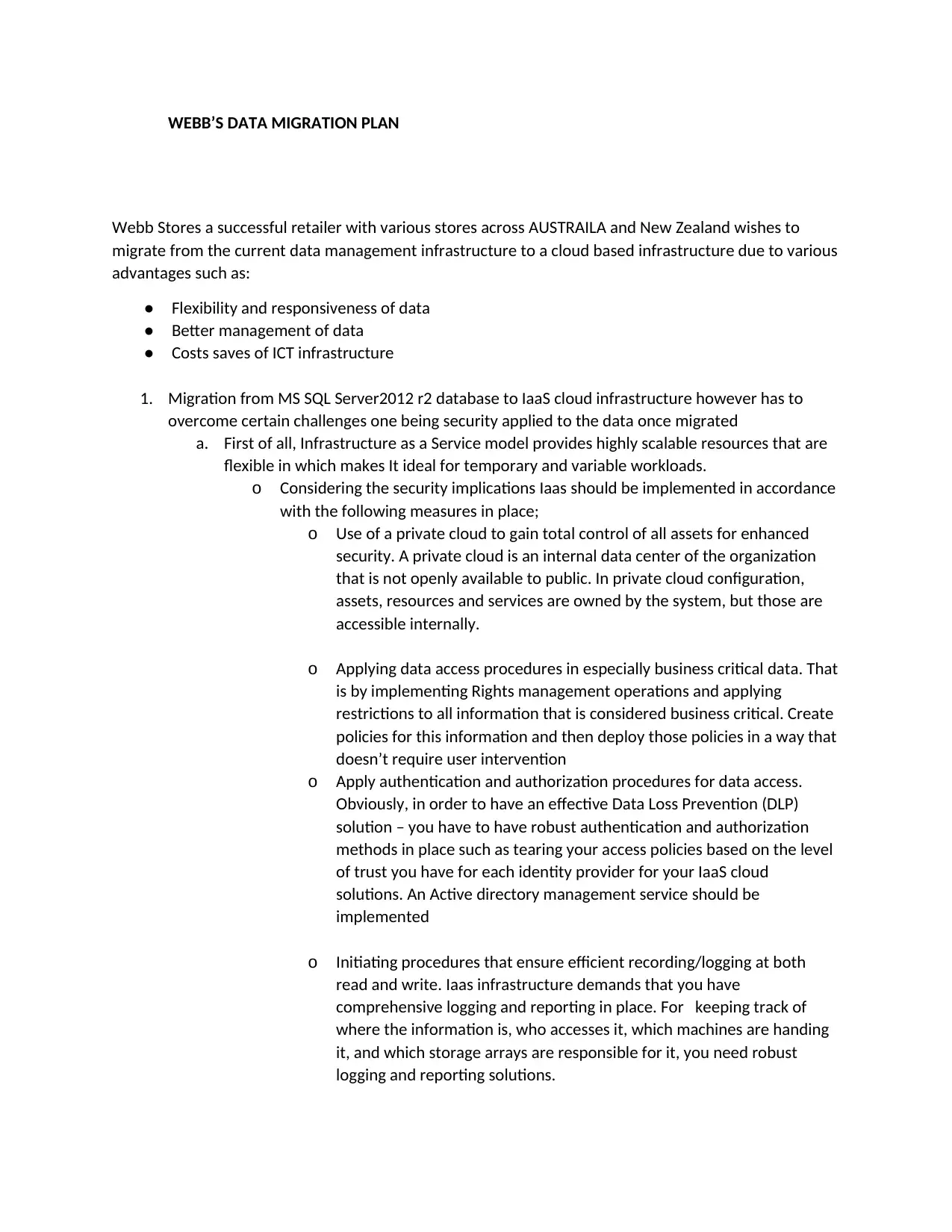
WEBB’S DATA MIGRATION PLAN
Webb Stores a successful retailer with various stores across AUSTRAILA and New Zealand wishes to
migrate from the current data management infrastructure to a cloud based infrastructure due to various
advantages such as:
● Flexibility and responsiveness of data
● Better management of data
● Costs saves of ICT infrastructure
1. Migration from MS SQL Server2012 r2 database to IaaS cloud infrastructure however has to
overcome certain challenges one being security applied to the data once migrated
a. First of all, Infrastructure as a Service model provides highly scalable resources that are
flexible in which makes It ideal for temporary and variable workloads.
o Considering the security implications Iaas should be implemented in accordance
with the following measures in place;
o Use of a private cloud to gain total control of all assets for enhanced
security. A private cloud is an internal data center of the organization
that is not openly available to public. In private cloud configuration,
assets, resources and services are owned by the system, but those are
accessible internally.
o Applying data access procedures in especially business critical data. That
is by implementing Rights management operations and applying
restrictions to all information that is considered business critical. Create
policies for this information and then deploy those policies in a way that
doesn’t require user intervention
o Apply authentication and authorization procedures for data access.
Obviously, in order to have an effective Data Loss Prevention (DLP)
solution – you have to have robust authentication and authorization
methods in place such as tearing your access policies based on the level
of trust you have for each identity provider for your IaaS cloud
solutions. An Active directory management service should be
implemented
o Initiating procedures that ensure efficient recording/logging at both
read and write. Iaas infrastructure demands that you have
comprehensive logging and reporting in place. For keeping track of
where the information is, who accesses it, which machines are handing
it, and which storage arrays are responsible for it, you need robust
logging and reporting solutions.
Webb Stores a successful retailer with various stores across AUSTRAILA and New Zealand wishes to
migrate from the current data management infrastructure to a cloud based infrastructure due to various
advantages such as:
● Flexibility and responsiveness of data
● Better management of data
● Costs saves of ICT infrastructure
1. Migration from MS SQL Server2012 r2 database to IaaS cloud infrastructure however has to
overcome certain challenges one being security applied to the data once migrated
a. First of all, Infrastructure as a Service model provides highly scalable resources that are
flexible in which makes It ideal for temporary and variable workloads.
o Considering the security implications Iaas should be implemented in accordance
with the following measures in place;
o Use of a private cloud to gain total control of all assets for enhanced
security. A private cloud is an internal data center of the organization
that is not openly available to public. In private cloud configuration,
assets, resources and services are owned by the system, but those are
accessible internally.
o Applying data access procedures in especially business critical data. That
is by implementing Rights management operations and applying
restrictions to all information that is considered business critical. Create
policies for this information and then deploy those policies in a way that
doesn’t require user intervention
o Apply authentication and authorization procedures for data access.
Obviously, in order to have an effective Data Loss Prevention (DLP)
solution – you have to have robust authentication and authorization
methods in place such as tearing your access policies based on the level
of trust you have for each identity provider for your IaaS cloud
solutions. An Active directory management service should be
implemented
o Initiating procedures that ensure efficient recording/logging at both
read and write. Iaas infrastructure demands that you have
comprehensive logging and reporting in place. For keeping track of
where the information is, who accesses it, which machines are handing
it, and which storage arrays are responsible for it, you need robust
logging and reporting solutions.
Paraphrase This Document
Need a fresh take? Get an instant paraphrase of this document with our AI Paraphraser
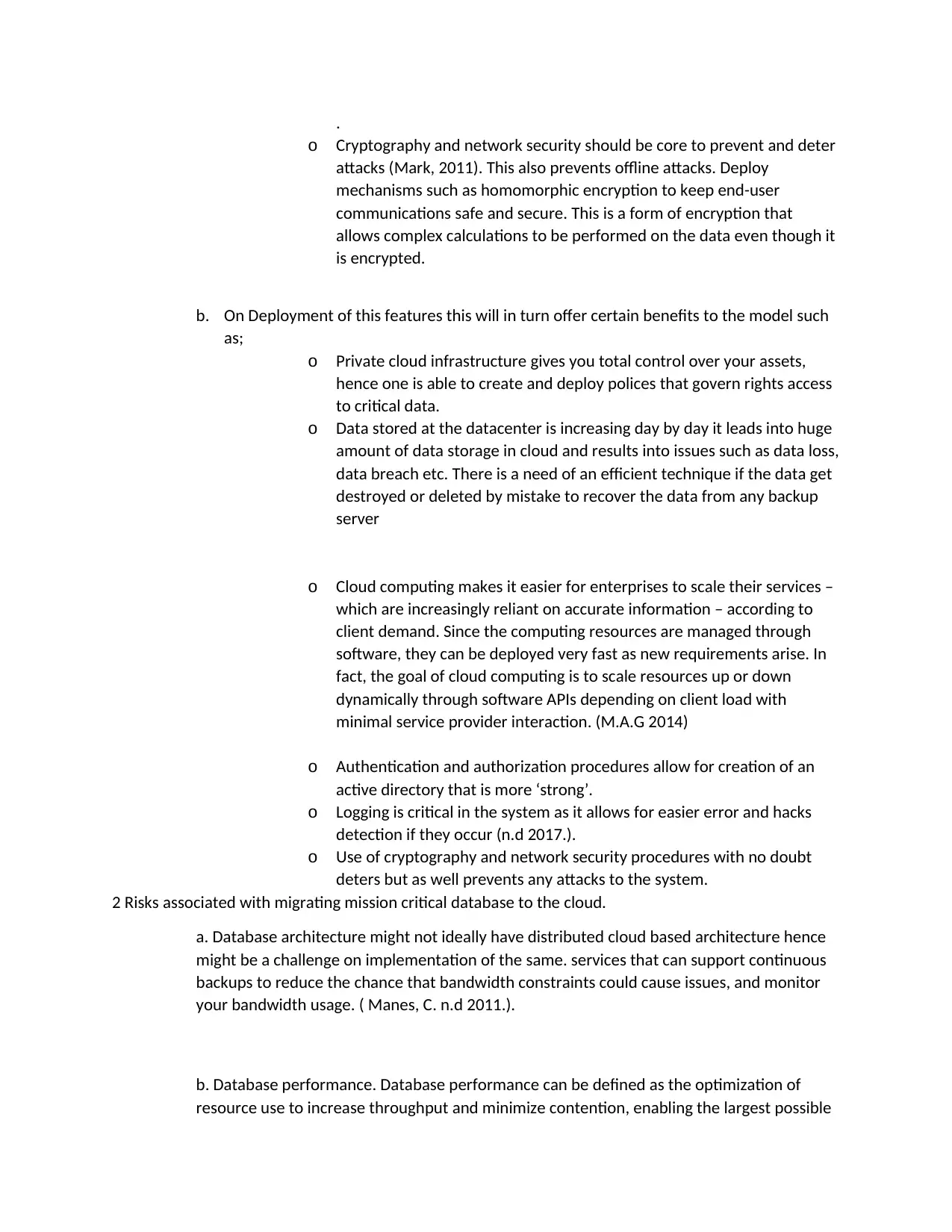
.
o Cryptography and network security should be core to prevent and deter
attacks (Mark, 2011). This also prevents offline attacks. Deploy
mechanisms such as homomorphic encryption to keep end-user
communications safe and secure. This is a form of encryption that
allows complex calculations to be performed on the data even though it
is encrypted.
b. On Deployment of this features this will in turn offer certain benefits to the model such
as;
o Private cloud infrastructure gives you total control over your assets,
hence one is able to create and deploy polices that govern rights access
to critical data.
o Data stored at the datacenter is increasing day by day it leads into huge
amount of data storage in cloud and results into issues such as data loss,
data breach etc. There is a need of an efficient technique if the data get
destroyed or deleted by mistake to recover the data from any backup
server
o Cloud computing makes it easier for enterprises to scale their services –
which are increasingly reliant on accurate information – according to
client demand. Since the computing resources are managed through
software, they can be deployed very fast as new requirements arise. In
fact, the goal of cloud computing is to scale resources up or down
dynamically through software APIs depending on client load with
minimal service provider interaction. (M.A.G 2014)
o Authentication and authorization procedures allow for creation of an
active directory that is more ‘strong’.
o Logging is critical in the system as it allows for easier error and hacks
detection if they occur (n.d 2017.).
o Use of cryptography and network security procedures with no doubt
deters but as well prevents any attacks to the system.
2 Risks associated with migrating mission critical database to the cloud.
a. Database architecture might not ideally have distributed cloud based architecture hence
might be a challenge on implementation of the same. services that can support continuous
backups to reduce the chance that bandwidth constraints could cause issues, and monitor
your bandwidth usage. ( Manes, C. n.d 2011.).
b. Database performance. Database performance can be defined as the optimization of
resource use to increase throughput and minimize contention, enabling the largest possible
o Cryptography and network security should be core to prevent and deter
attacks (Mark, 2011). This also prevents offline attacks. Deploy
mechanisms such as homomorphic encryption to keep end-user
communications safe and secure. This is a form of encryption that
allows complex calculations to be performed on the data even though it
is encrypted.
b. On Deployment of this features this will in turn offer certain benefits to the model such
as;
o Private cloud infrastructure gives you total control over your assets,
hence one is able to create and deploy polices that govern rights access
to critical data.
o Data stored at the datacenter is increasing day by day it leads into huge
amount of data storage in cloud and results into issues such as data loss,
data breach etc. There is a need of an efficient technique if the data get
destroyed or deleted by mistake to recover the data from any backup
server
o Cloud computing makes it easier for enterprises to scale their services –
which are increasingly reliant on accurate information – according to
client demand. Since the computing resources are managed through
software, they can be deployed very fast as new requirements arise. In
fact, the goal of cloud computing is to scale resources up or down
dynamically through software APIs depending on client load with
minimal service provider interaction. (M.A.G 2014)
o Authentication and authorization procedures allow for creation of an
active directory that is more ‘strong’.
o Logging is critical in the system as it allows for easier error and hacks
detection if they occur (n.d 2017.).
o Use of cryptography and network security procedures with no doubt
deters but as well prevents any attacks to the system.
2 Risks associated with migrating mission critical database to the cloud.
a. Database architecture might not ideally have distributed cloud based architecture hence
might be a challenge on implementation of the same. services that can support continuous
backups to reduce the chance that bandwidth constraints could cause issues, and monitor
your bandwidth usage. ( Manes, C. n.d 2011.).
b. Database performance. Database performance can be defined as the optimization of
resource use to increase throughput and minimize contention, enabling the largest possible
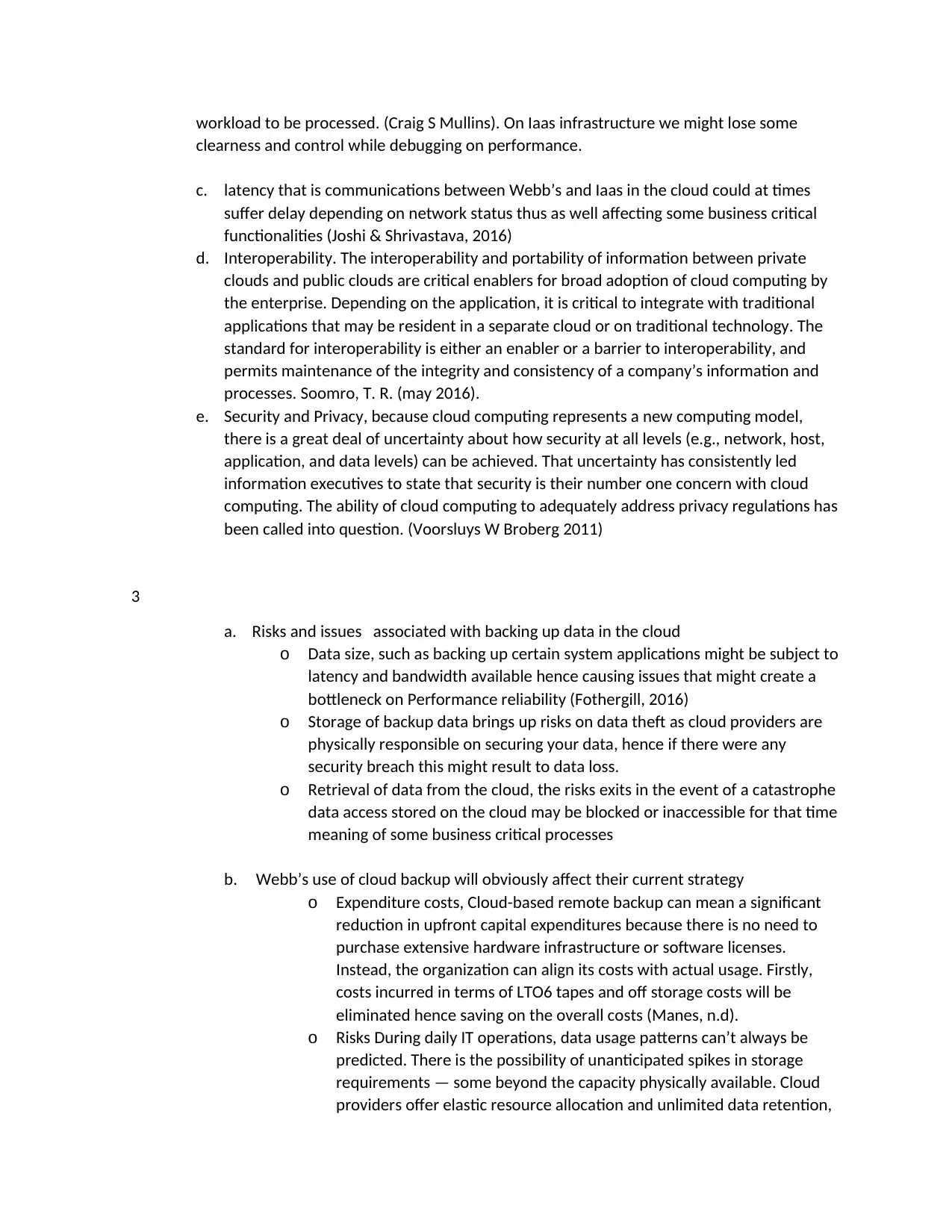
workload to be processed. (Craig S Mullins). On Iaas infrastructure we might lose some
clearness and control while debugging on performance.
c. latency that is communications between Webb’s and Iaas in the cloud could at times
suffer delay depending on network status thus as well affecting some business critical
functionalities (Joshi & Shrivastava, 2016)
d. Interoperability. The interoperability and portability of information between private
clouds and public clouds are critical enablers for broad adoption of cloud computing by
the enterprise. Depending on the application, it is critical to integrate with traditional
applications that may be resident in a separate cloud or on traditional technology. The
standard for interoperability is either an enabler or a barrier to interoperability, and
permits maintenance of the integrity and consistency of a company’s information and
processes. Soomro, T. R. (may 2016).
e. Security and Privacy, because cloud computing represents a new computing model,
there is a great deal of uncertainty about how security at all levels (e.g., network, host,
application, and data levels) can be achieved. That uncertainty has consistently led
information executives to state that security is their number one concern with cloud
computing. The ability of cloud computing to adequately address privacy regulations has
been called into question. (Voorsluys W Broberg 2011)
3
a. Risks and issues associated with backing up data in the cloud
o Data size, such as backing up certain system applications might be subject to
latency and bandwidth available hence causing issues that might create a
bottleneck on Performance reliability (Fothergill, 2016)
o Storage of backup data brings up risks on data theft as cloud providers are
physically responsible on securing your data, hence if there were any
security breach this might result to data loss.
o Retrieval of data from the cloud, the risks exits in the event of a catastrophe
data access stored on the cloud may be blocked or inaccessible for that time
meaning of some business critical processes
b. Webb’s use of cloud backup will obviously affect their current strategy
o Expenditure costs, Cloud-based remote backup can mean a significant
reduction in upfront capital expenditures because there is no need to
purchase extensive hardware infrastructure or software licenses.
Instead, the organization can align its costs with actual usage. Firstly,
costs incurred in terms of LTO6 tapes and off storage costs will be
eliminated hence saving on the overall costs (Manes, n.d).
o Risks During daily IT operations, data usage patterns can’t always be
predicted. There is the possibility of unanticipated spikes in storage
requirements — some beyond the capacity physically available. Cloud
providers offer elastic resource allocation and unlimited data retention,
clearness and control while debugging on performance.
c. latency that is communications between Webb’s and Iaas in the cloud could at times
suffer delay depending on network status thus as well affecting some business critical
functionalities (Joshi & Shrivastava, 2016)
d. Interoperability. The interoperability and portability of information between private
clouds and public clouds are critical enablers for broad adoption of cloud computing by
the enterprise. Depending on the application, it is critical to integrate with traditional
applications that may be resident in a separate cloud or on traditional technology. The
standard for interoperability is either an enabler or a barrier to interoperability, and
permits maintenance of the integrity and consistency of a company’s information and
processes. Soomro, T. R. (may 2016).
e. Security and Privacy, because cloud computing represents a new computing model,
there is a great deal of uncertainty about how security at all levels (e.g., network, host,
application, and data levels) can be achieved. That uncertainty has consistently led
information executives to state that security is their number one concern with cloud
computing. The ability of cloud computing to adequately address privacy regulations has
been called into question. (Voorsluys W Broberg 2011)
3
a. Risks and issues associated with backing up data in the cloud
o Data size, such as backing up certain system applications might be subject to
latency and bandwidth available hence causing issues that might create a
bottleneck on Performance reliability (Fothergill, 2016)
o Storage of backup data brings up risks on data theft as cloud providers are
physically responsible on securing your data, hence if there were any
security breach this might result to data loss.
o Retrieval of data from the cloud, the risks exits in the event of a catastrophe
data access stored on the cloud may be blocked or inaccessible for that time
meaning of some business critical processes
b. Webb’s use of cloud backup will obviously affect their current strategy
o Expenditure costs, Cloud-based remote backup can mean a significant
reduction in upfront capital expenditures because there is no need to
purchase extensive hardware infrastructure or software licenses.
Instead, the organization can align its costs with actual usage. Firstly,
costs incurred in terms of LTO6 tapes and off storage costs will be
eliminated hence saving on the overall costs (Manes, n.d).
o Risks During daily IT operations, data usage patterns can’t always be
predicted. There is the possibility of unanticipated spikes in storage
requirements — some beyond the capacity physically available. Cloud
providers offer elastic resource allocation and unlimited data retention,
⊘ This is a preview!⊘
Do you want full access?
Subscribe today to unlock all pages.

Trusted by 1+ million students worldwide
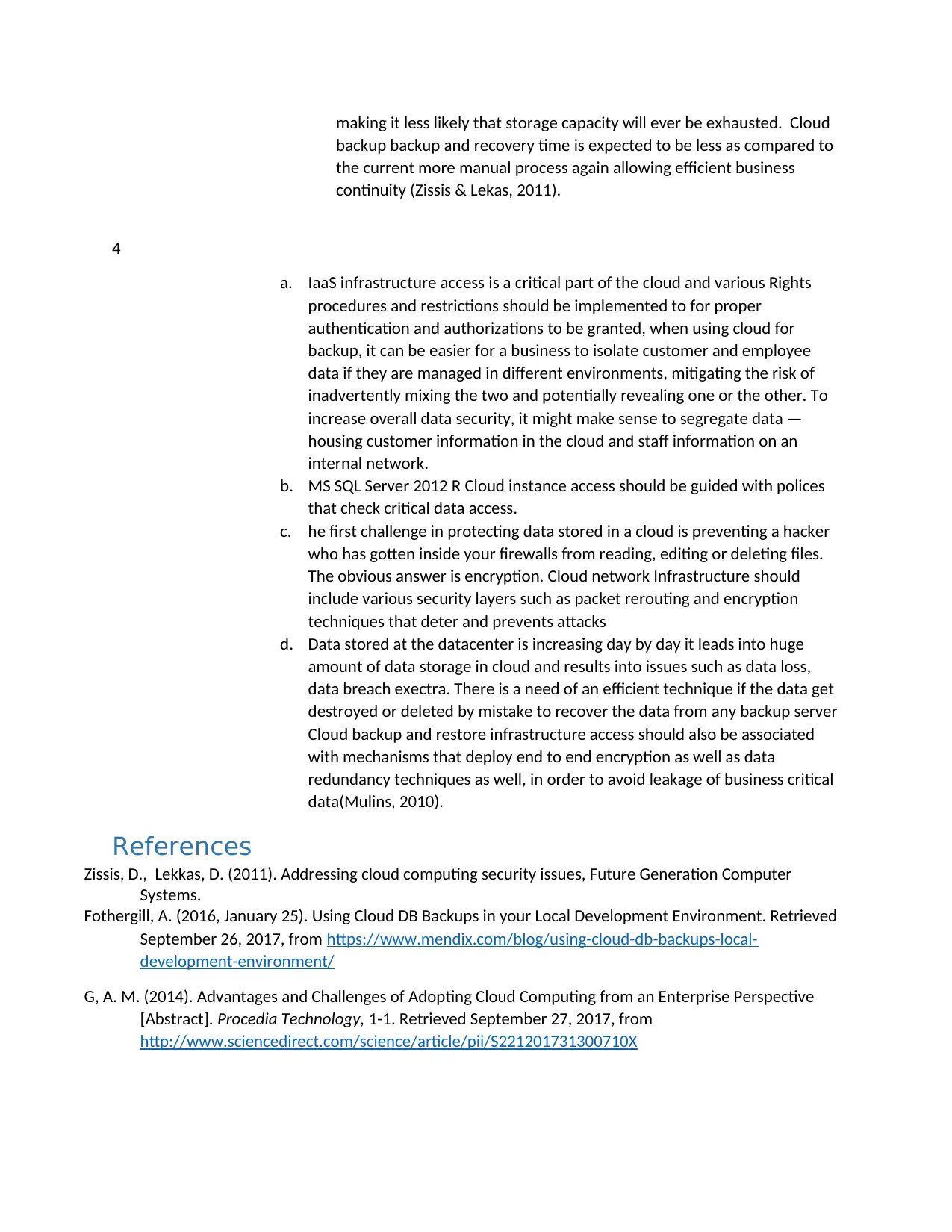
making it less likely that storage capacity will ever be exhausted. Cloud
backup backup and recovery time is expected to be less as compared to
the current more manual process again allowing efficient business
continuity (Zissis & Lekas, 2011).
4
a. IaaS infrastructure access is a critical part of the cloud and various Rights
procedures and restrictions should be implemented to for proper
authentication and authorizations to be granted, when using cloud for
backup, it can be easier for a business to isolate customer and employee
data if they are managed in different environments, mitigating the risk of
inadvertently mixing the two and potentially revealing one or the other. To
increase overall data security, it might make sense to segregate data —
housing customer information in the cloud and staff information on an
internal network.
b. MS SQL Server 2012 R Cloud instance access should be guided with polices
that check critical data access.
c. he first challenge in protecting data stored in a cloud is preventing a hacker
who has gotten inside your firewalls from reading, editing or deleting files.
The obvious answer is encryption. Cloud network Infrastructure should
include various security layers such as packet rerouting and encryption
techniques that deter and prevents attacks
d. Data stored at the datacenter is increasing day by day it leads into huge
amount of data storage in cloud and results into issues such as data loss,
data breach exectra. There is a need of an efficient technique if the data get
destroyed or deleted by mistake to recover the data from any backup server
Cloud backup and restore infrastructure access should also be associated
with mechanisms that deploy end to end encryption as well as data
redundancy techniques as well, in order to avoid leakage of business critical
data(Mulins, 2010).
References
Zissis, D., Lekkas, D. (2011). Addressing cloud computing security issues, Future Generation Computer
Systems.
Fothergill, A. (2016, January 25). Using Cloud DB Backups in your Local Development Environment. Retrieved
September 26, 2017, from https://www.mendix.com/blog/using-cloud-db-backups-local-
development-environment/
G, A. M. (2014). Advantages and Challenges of Adopting Cloud Computing from an Enterprise Perspective
[Abstract]. Procedia Technology, 1-1. Retrieved September 27, 2017, from
http://www.sciencedirect.com/science/article/pii/S221201731300710X
backup backup and recovery time is expected to be less as compared to
the current more manual process again allowing efficient business
continuity (Zissis & Lekas, 2011).
4
a. IaaS infrastructure access is a critical part of the cloud and various Rights
procedures and restrictions should be implemented to for proper
authentication and authorizations to be granted, when using cloud for
backup, it can be easier for a business to isolate customer and employee
data if they are managed in different environments, mitigating the risk of
inadvertently mixing the two and potentially revealing one or the other. To
increase overall data security, it might make sense to segregate data —
housing customer information in the cloud and staff information on an
internal network.
b. MS SQL Server 2012 R Cloud instance access should be guided with polices
that check critical data access.
c. he first challenge in protecting data stored in a cloud is preventing a hacker
who has gotten inside your firewalls from reading, editing or deleting files.
The obvious answer is encryption. Cloud network Infrastructure should
include various security layers such as packet rerouting and encryption
techniques that deter and prevents attacks
d. Data stored at the datacenter is increasing day by day it leads into huge
amount of data storage in cloud and results into issues such as data loss,
data breach exectra. There is a need of an efficient technique if the data get
destroyed or deleted by mistake to recover the data from any backup server
Cloud backup and restore infrastructure access should also be associated
with mechanisms that deploy end to end encryption as well as data
redundancy techniques as well, in order to avoid leakage of business critical
data(Mulins, 2010).
References
Zissis, D., Lekkas, D. (2011). Addressing cloud computing security issues, Future Generation Computer
Systems.
Fothergill, A. (2016, January 25). Using Cloud DB Backups in your Local Development Environment. Retrieved
September 26, 2017, from https://www.mendix.com/blog/using-cloud-db-backups-local-
development-environment/
G, A. M. (2014). Advantages and Challenges of Adopting Cloud Computing from an Enterprise Perspective
[Abstract]. Procedia Technology, 1-1. Retrieved September 27, 2017, from
http://www.sciencedirect.com/science/article/pii/S221201731300710X
Paraphrase This Document
Need a fresh take? Get an instant paraphrase of this document with our AI Paraphraser
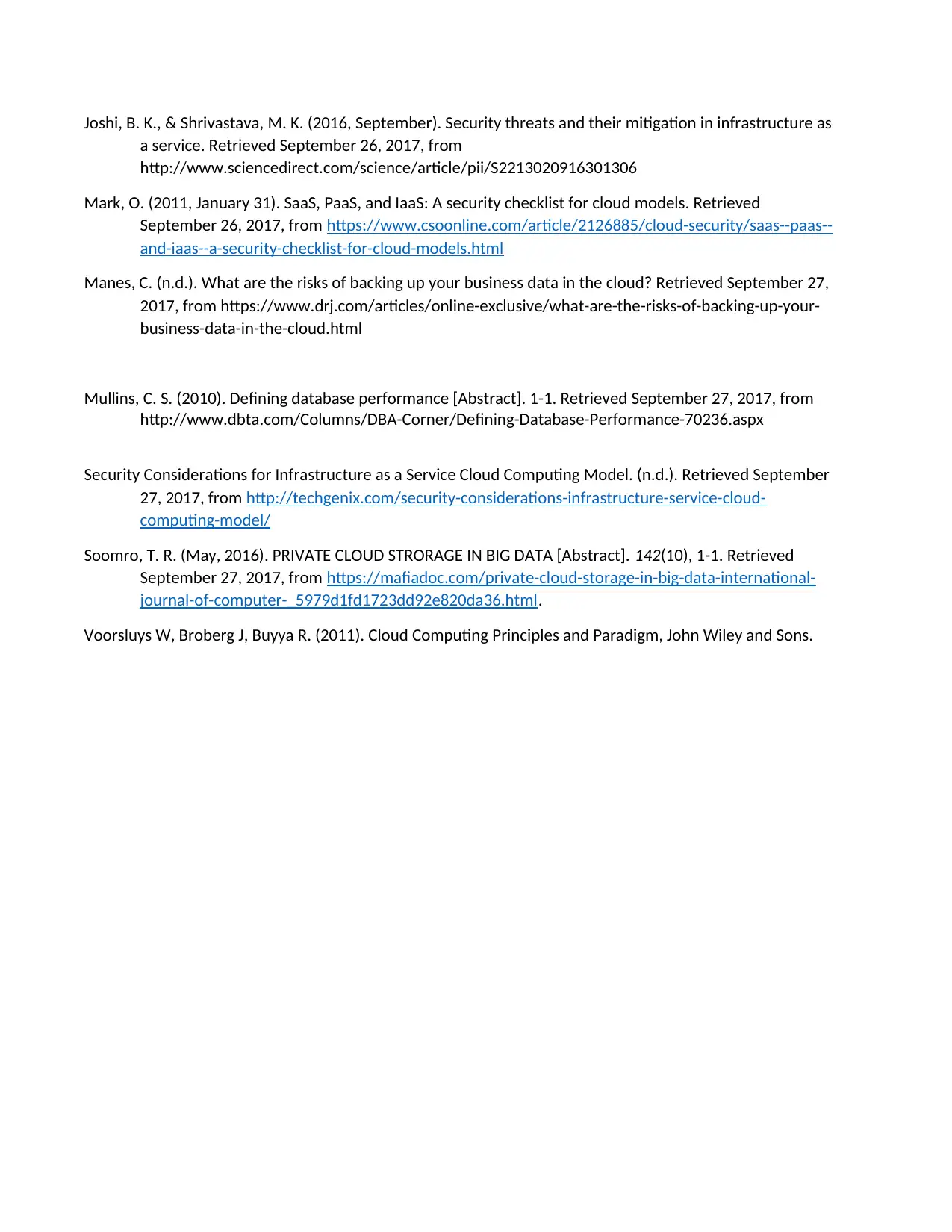
Joshi, B. K., & Shrivastava, M. K. (2016, September). Security threats and their mitigation in infrastructure as
a service. Retrieved September 26, 2017, from
http://www.sciencedirect.com/science/article/pii/S2213020916301306
Mark, O. (2011, January 31). SaaS, PaaS, and IaaS: A security checklist for cloud models. Retrieved
September 26, 2017, from https://www.csoonline.com/article/2126885/cloud-security/saas--paas--
and-iaas--a-security-checklist-for-cloud-models.html
Manes, C. (n.d.). What are the risks of backing up your business data in the cloud? Retrieved September 27,
2017, from https://www.drj.com/articles/online-exclusive/what-are-the-risks-of-backing-up-your-
business-data-in-the-cloud.html
Mullins, C. S. (2010). Defining database performance [Abstract]. 1-1. Retrieved September 27, 2017, from
http://www.dbta.com/Columns/DBA-Corner/Defining-Database-Performance-70236.aspx
Security Considerations for Infrastructure as a Service Cloud Computing Model. (n.d.). Retrieved September
27, 2017, from http://techgenix.com/security-considerations-infrastructure-service-cloud-
computing-model/
Soomro, T. R. (May, 2016). PRIVATE CLOUD STRORAGE IN BIG DATA [Abstract]. 142(10), 1-1. Retrieved
September 27, 2017, from https://mafiadoc.com/private-cloud-storage-in-big-data-international-
journal-of-computer-_5979d1fd1723dd92e820da36.html.
Voorsluys W, Broberg J, Buyya R. (2011). Cloud Computing Principles and Paradigm, John Wiley and Sons.
a service. Retrieved September 26, 2017, from
http://www.sciencedirect.com/science/article/pii/S2213020916301306
Mark, O. (2011, January 31). SaaS, PaaS, and IaaS: A security checklist for cloud models. Retrieved
September 26, 2017, from https://www.csoonline.com/article/2126885/cloud-security/saas--paas--
and-iaas--a-security-checklist-for-cloud-models.html
Manes, C. (n.d.). What are the risks of backing up your business data in the cloud? Retrieved September 27,
2017, from https://www.drj.com/articles/online-exclusive/what-are-the-risks-of-backing-up-your-
business-data-in-the-cloud.html
Mullins, C. S. (2010). Defining database performance [Abstract]. 1-1. Retrieved September 27, 2017, from
http://www.dbta.com/Columns/DBA-Corner/Defining-Database-Performance-70236.aspx
Security Considerations for Infrastructure as a Service Cloud Computing Model. (n.d.). Retrieved September
27, 2017, from http://techgenix.com/security-considerations-infrastructure-service-cloud-
computing-model/
Soomro, T. R. (May, 2016). PRIVATE CLOUD STRORAGE IN BIG DATA [Abstract]. 142(10), 1-1. Retrieved
September 27, 2017, from https://mafiadoc.com/private-cloud-storage-in-big-data-international-
journal-of-computer-_5979d1fd1723dd92e820da36.html.
Voorsluys W, Broberg J, Buyya R. (2011). Cloud Computing Principles and Paradigm, John Wiley and Sons.
1 out of 5
Related Documents
Your All-in-One AI-Powered Toolkit for Academic Success.
+13062052269
info@desklib.com
Available 24*7 on WhatsApp / Email
![[object Object]](/_next/static/media/star-bottom.7253800d.svg)
Unlock your academic potential
Copyright © 2020–2025 A2Z Services. All Rights Reserved. Developed and managed by ZUCOL.





